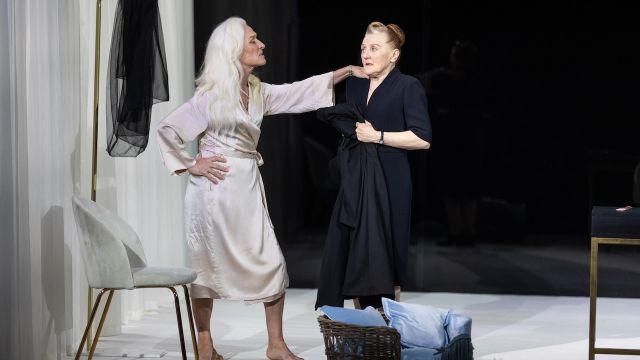The President
Onto the stage walked Mrs Frolick (Julie Forsyth), the servant of the President and the First Lady, meticulously preparing the military uniform of the glorious leader, who laughs and coughs ominously offstage in a bathtub.
In a stark and shiny room, the first couple were preparing to attend the funeral of the Colonel, who was freshly assassinated by an anarchist, who narrowly missed knocking off the leader of this unnamed country.

A mixture of dark humour and suffocating tension permeated this opening scene, with Olwen Fouéré as the First Lady firing off a rapid-fire monologue, barely punctuated by the occasional squeak from her servant.
She accuses her servant of torturing her, and claims she has nothing to fear, where it is obvious the opposite is the case.
With great relief, the President - Hugo Weaving finally leaves his bathtub and strides bare hairy chested into his dressing room.

The next scene is Weaving’s turn to shine, as he cavorts with a glamourous actress mistress (Kate Gilmore) at a shiny restaurant on the coast.
In a free-wheeling monologue, The President pontificates that his country is too small for his political talent, vilifies casting directors who don’t give his lover big enough roles to perform, and complains about his dysfunctional marriage.
Weaving carved up this scene which is full of bravado as he gets progressively more and more sloshed.

Despite the highly charged nature of being a Dictator of a small country, and having to dodge regular assassination attempts, there is a stillness in this play and stage movement is minimal.
There are overly long scenes where the President and his wife are seated, talking about the maelstrom of drama around them. This focusses attention on the charisma and talent of the two leads which is considerable, but it is shame they don’t get the opportunity to properly fire off against each other in the same scene.

The Austrian playwright Thomas Bernhard has a fascinating background – forced as a child into the Hitler youth, which he hated, he lived through the experience of a Dictator and had many European leaders to draw upon.
The play was first staged in 1975 and has never been seen in Australia – partly because for a while after the playwright’s death his will precluded (for an extended period) any new productions, and partly because of the difficulties in staging the work well.
He provides insights into the minds of a Dictator which ring true today. The modern and sleek design by Elizabeth Gadsby gives the play a contemporary feel.

This joint production between The Sydney Theatre Company and the Ireland’s Gate Theatre will satisfy those who want to see blockbuster actors ply their craft.
The ending that is both predictable and thoroughly unique, ensuring those watching will not easily be able to forget it.
David Spicer
Photographer: Daniel Boud
Subscribe to our E-Newsletter, buy our latest print edition or find a Performing Arts book at Book Nook.

